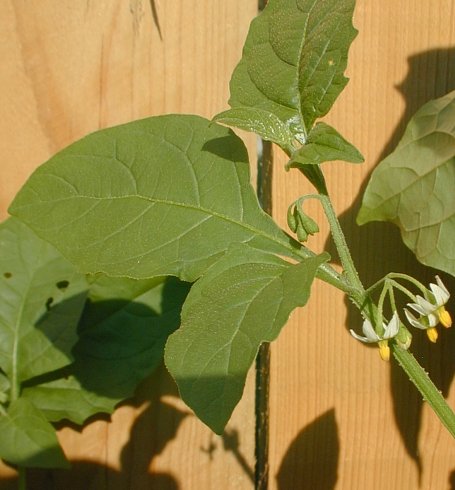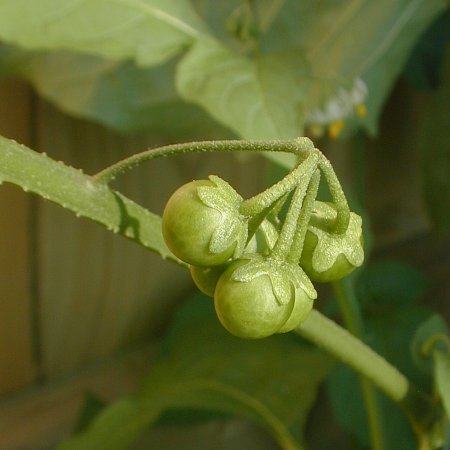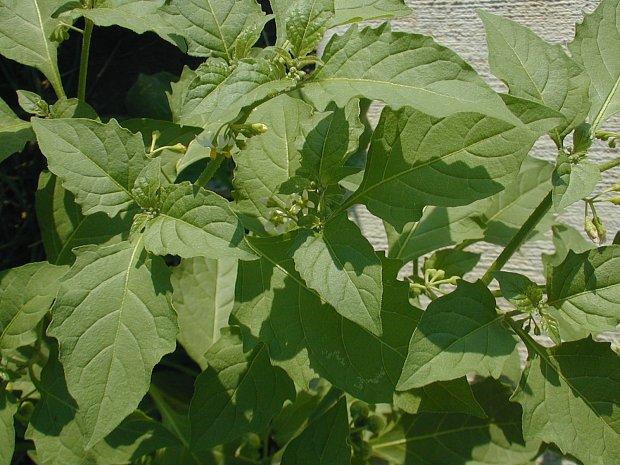Description: This annual plant is about 1-3' tall, branching frequently above. The stems are glabrous to slightly short-hairy, but not prickly. The alternate leaves are up to 3" long and 2" across; they are usually broadly lanceolate, ovate, oval, or oval-deltate in shape, while their margins are smooth, undulate, or bluntly dentate. The leaf surfaces are medium green to dark green and glabrous to slightly short-hairy; when hairs are present, they are usually more common along the leaf undersides. The petioles are relatively long and partially winged toward their blades. Solitary umbels of nodding white flowers (rarely violet-purple flowers) occasionally develop from the axils of the middle to upper leaves. Each umbel has 3-10 flowers. The peduncles of the umbels are about ¾" long, while the pedicels of the flowers are about one-half of this length. Both the peduncles and pedicels are green, slender, and glabrous to slightly short-hairy. Each flower is about 6-8 mm. across, consisting of a star-like white corolla with 5 tapering lobes that curve backward. Projecting from the center of the corolla, there are 5 stamens with large yellow anthers that are appressed together against the pistil. The green sepals are connected to each other at the base of the flower; they are lanceolate-oblong in shape.

The blooming
period usually occurs during the summer or early fall. A single plant
may produce flowers sporadically for about 2 months. The flowers are
replaced by small globoid berries about 6-8 mm. across. The outer
surface of the berries is initially green and smooth, but it
later becomes black and shiny. Mature berries are juicy, bland to
sweet, and sometimes slightly bitter; each berry contains
numerous flattened seeds that are yellow or
brown. The root system consists of a slender taproot that branches
frequently. This plant spreads by reseeding itself.
Cultivation:
Black Nightshade is an adaptable plant that flourishes in full or
partial sun, moist to mesic situations, and almost any kind of soil,
especially fertile loam with abundant nitrogen. The size of a plant
depends heavily on
moisture levels and soil fertility.
Range & Habitat:
This common plant has been observed in most counties of Illinois (see Distribution
Map), where it is native. Habitats include thickets,
openings in degraded
woodlands, thinly wooded bluffs, cropland and pastures,
gardens, vacant lots,
areas along railroads, fence rows, back alleys in urban areas, and
waste areas. This plant is more common at
sites with a history of disturbance and it is rather weedy. Most
authorities consider Solanum ptycanthum (Black
Nightshade) to be distinct from the European Solanum nigrum
(Deadly Nightshade).

Faunal
Associations:
Bumblebees collect pollen from the flowers (Robertson, 1929). Nectar is
unavailable as a floral reward. Several species of insects
feed destructively on Black Nightshade, especially the larvae and
adults of leaf beetles (Chrysomelidae). This includes such species as Acallepitrix nitens
(a leaf beetle), Epitrix
cucumeris (American Potato Flea Beetle), Epitrix fuscula
(Eggplant Flea Beetle), Epitrix
hirtipennis (Tobacco Flea Beetle), Lema daturaphila
(Three-lined Potato Beetle), Lema
trivittata (Three-lined Lema Beetle), Leptinotarsa decemlineata
(Colorado Potato Beetle), Plagiometriona
clavata (Clavate Tortoise Beetle), Psylliodes affinis
(European Potato Flea Beetle), larvae of the moths Heliothis subflexus
(Subflexus Straw) and Manduca
sexta (Tobacco Hornworm), and maggots of Liriomyza trifolii
(American
Serpentine Leafminer); see Clark et al. (2004), Covell (1984/2005),
Wagner (2005), and Spencer & Steyskal (1986). The mature fruits
of Solanum spp.
(nightshade species), including those of Black Nightshade, are eaten by
various species of birds and mammals. This includes such birds as the
Ruffed Grouse, Wild Turkey, Eastern Meadowlark, Gray Catbird, and Swamp
Sparrow; the Bird Table has a more
complete list of such species. Mammals
that eat the fruits of these plants include the Raccoon, Striped Skunk,
White-tailed Deer, and small rodents; see Martin et al. (1951/1961),
Myers et al. (2004), and Hamilton (1941). Because the seeds in these
fruits are able to pass through the digestive tracts of many animals
and remain viable, they are distributed across considerable distances,
introducing this plant into new areas. The foliage of Black Nightshade
is toxic and bitter, therefore
it is usually avoided by mammalian herbivores (Georgia, 1913).

Photographic
Location:
On the grounds of the webmaster's apartment complex in Urbana, Illinois.
Comments:
The berries of Black Nightshade (Solanum ptycanthum)
are probably edible to humans, if they are fully
ripe and eaten in small quantities. Green berries contain the toxic
alkaloid, solanum, like the foliage. There are several Solanum
spp. that occur in Illinois. They fall into two groups: Those
species with sharp bristles or spines, and those species without sharp
bristles or spines. Black Nightshade falls into the latter group. In
Illinois, the Solanum
spp. in this latter group can be distinguished from each
other by the appearance of their leaves: Black Nightshade has broader
leaves that are without deep lobes along their sides, and they lack
conspicuous silvery hairs. Some Solanum spp. have
mature berries that are either green or yellow, but the mature berries
of Black Nightshade are always black. The berries of Black Nightshade
are slightly smaller in size and more shiny than those of Deadly
Nightshade (Solanum nigrum), and its seeds are
slightly smaller in size than those of the latter. Black Nightshade
produces true umbels of flowers (all pedicels originating from the same
location), while Deadly Nightshade produces pseudo-umbels of flowers
(the pedicels originating from slightly different locations). This
latter species has not been recorded from Illinois. A scientific
synonym of Black Nightshade is Solanum
americanum.